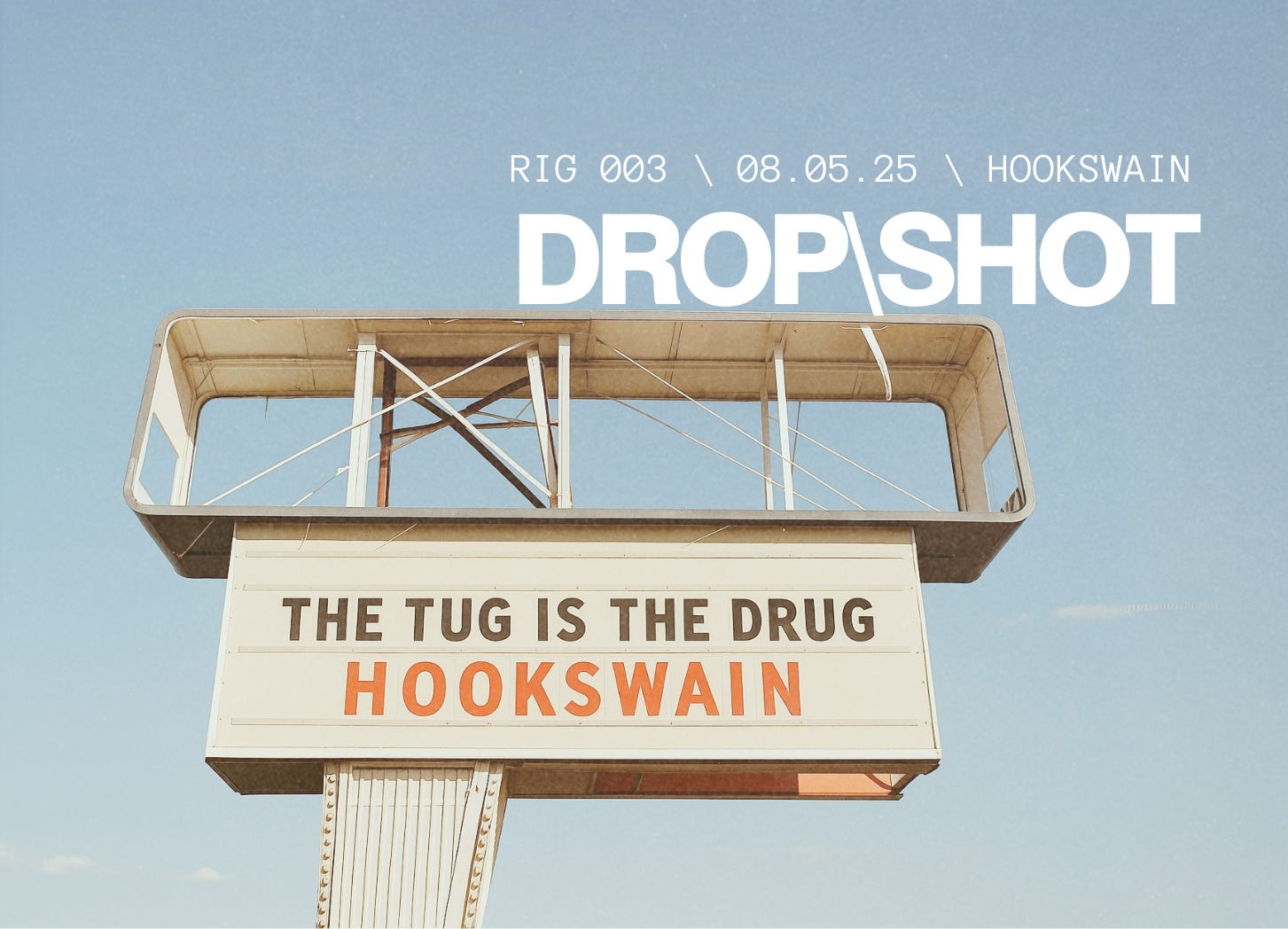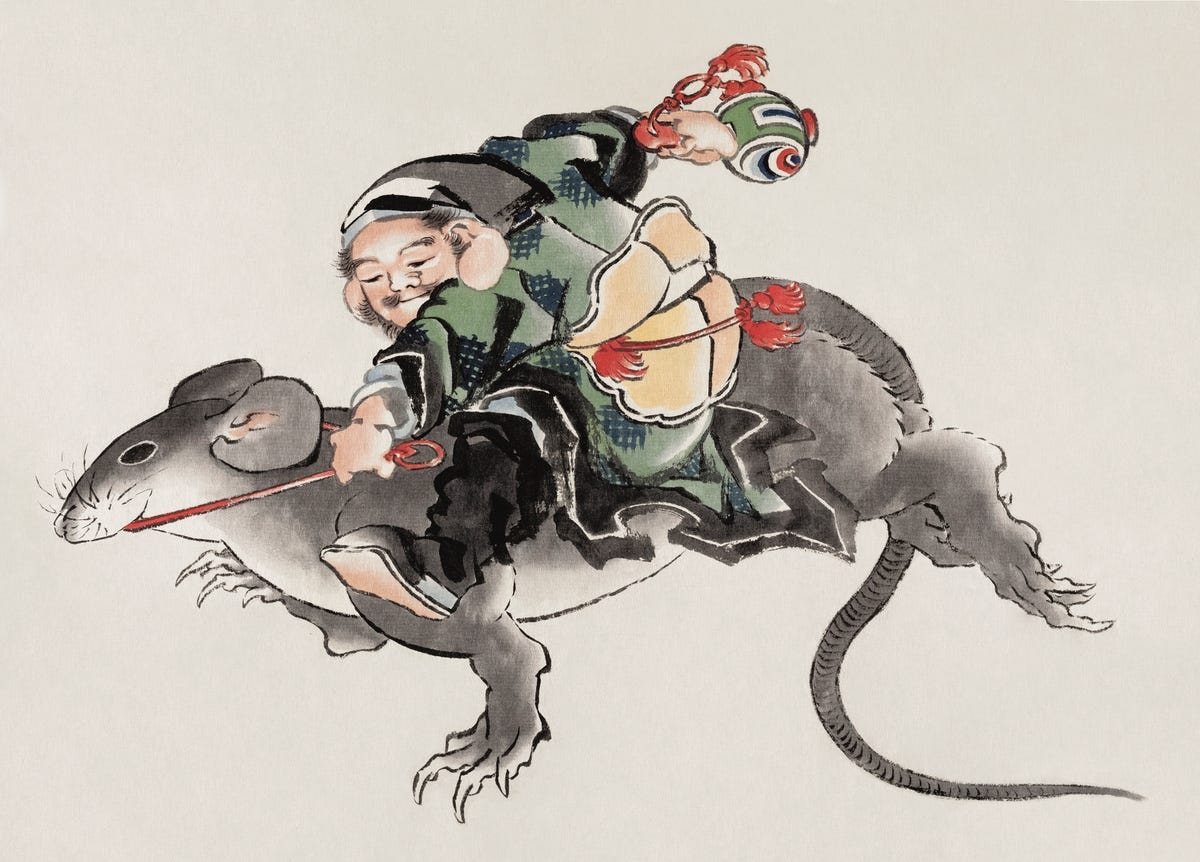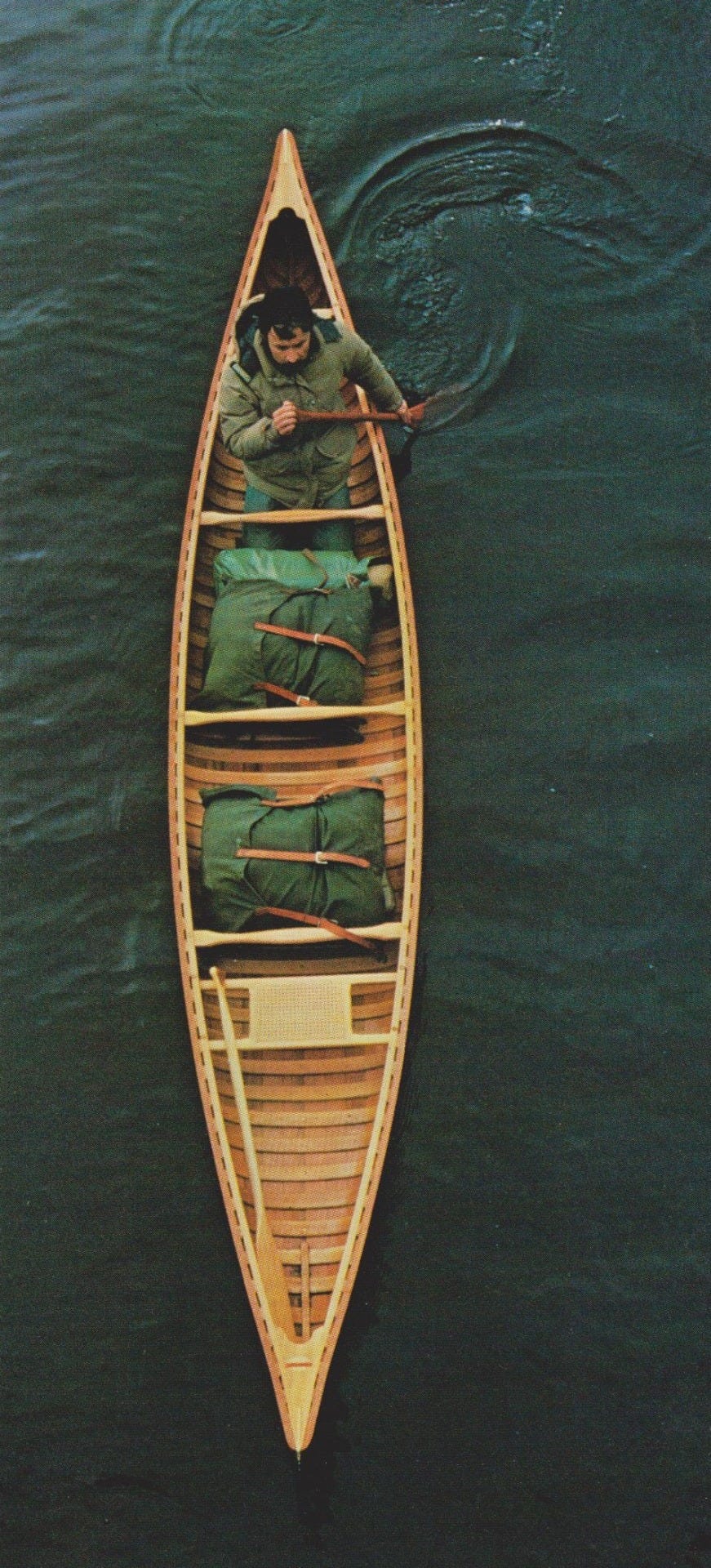Of Mice and Men
Somewhere in the darkness, at a distance too warped by the quietness of nighttime and the wide open river and the cool air thickening into a fog, a toilet flushes.
It isn’t of course.
You know this.
But that’s what your ears hear.
There is only one other thing that makes that same sucking, gurgling sploosh and in the blackness, your mind completes the shape: the length and girth of the wild Delaware brown trout, a ghost that's just eaten like a king.
It could be 10:30PM or it could be 1AM. Out here, time loosens its grip. Drifting mid-current under a sky veiled in fog, you are neither early nor late. You are nowhere—and also precisely where you want to be: suspended in the hush, casting toward banks you can’t see but know by feel.
You fling the mouse out into the dark. The emissary of your camp’s shared delusion. It returns in a rat-a-tat of strips, small and sharp and frantic, a telegraph from the twitching edge of prey.
S.O.S.
The message, even in its caricatured translation of frenzied frantic fleeing, flirts with our wide-eyed imaginations of what lurks below.
Floating through the no-thingness, deprived of our eyes, we feel everything.
Grand.
Alive.
On the edge of something.
On the edge of ourselves.
Tuned into the shimmer of each vibration skipping up fried dendrites, half-dead from screens and sugar and comfort and the anesthesia of always-knowing and too much, too often.
And the mouse says: tap, tap, tap.
Don’t eat me.
Don’t.
Eat.
SPLOOSH.
MONOFILAMENT FM
“Trout Sermons: Night Run”
Entry ID: CX107
Classification: [Parallel Dimension Memory Loop]
Format: Intercepted Signal, Short Wave
Origin: Unknown
Notes: Hiss-heavy. Likely recorded during solar flare.
Warning: DO NOT REVERSE.Our servers intercepted a transmission from an unidentified, untraceable source.
Despite repeated analysis, the origin remains unresolved.
Current hypothesis: one of several fragments from a collection of orations known as “Trout Sermons,” believed to have leaked through a time-space rift from a parallel dimension.
Playback is authorized. Proceed with caution.
On the Banks of the Lonely River
On the banks of the Lonely River,
the song of the world plays.
Not in words, but in vibration.
Not in noise, but in breath.
The great organ of life exhales through itself in tones immutable, delicate,
unseen. It sings in days,
in wind,
in the hush of water on water.
I am here.
In that I have always been here.
In that I was never here.
In that I am lost like you and found again in shards of sunlight slicing through fingers of trees.
I am a stranger, thick with summer, rootless.
Ancient wanderlust beads between my shoulder blades and runs
to rejoin the sea.
I am excised from the womb of my beginning,
naked before the night.
The Lonely River runs deep into the earth.
Through the lashing of pagan tongues.
Through sacrifice and scripture and the rituals of becoming.
Through itself, to become itself.
It has no form, no destination.
No origin.
No urge.
It is the medium.
I am here in that I have come here.
Itinerant.
In search of redemption,
apotheosis,
forgiveness.
Permission to be
broken.
Definition strains at the edges of perception.
My mind is rabid with stars but forms no constellation.
I come rejoicing.
I come penitent.
Painted in the lost umber of the wild.
A child of progress.
A violator.
Smog-swilled,
skin-bound,
worthless flesh.
I come to prostrate before the enormity of nature.
Others have come here in search of themselves.
Their trails meander through grass and vanish into pools.
I trace them gravely, hoping to glimpse them
still clutching the gray frock of morning,
backs bent with quest,
conquering restless hearts
in the squinting quietude.
But they are not here.
As I am not here.
Eidolons of the myth.
Blackened matchsticks burned in psalm.
Between us, the sacred stones lie
breathless.
Flesh firm in torment.
Vermiculated by time and painted by cosmic brush.
Devouring.
Defiant.
Undulating like unfixed appendages, beating with the singular heart of the river.
I watch them sing their silent ululations,
mourning the solemn honor of their propagation
sheltered in their temple
of abundance.
Anatomy of a Nymph Rig
Nymphing is a way of life for many of us. The recommendations below are purely based on my experience and preferences which have largely been informed by Northeastern trout streams. Some aspects may be applicable to your fishery, and others may have to be altered/evolved for fishing elsewhere. - JWS
Basic Nymph Rig Setup
Typically, I select a heavy leader for nymphing. Something like a 3X leader works well. The stiffness of the 3X butt helps turn the rig over, and I have found that anything less than 3X diameter allows the indicator to slip (I like Airlocks in WHITE) down the leader when casting etc. I have tried both mono and flouro on nymph rigs and I haven't really decided which works better. This is something I go back and forth on. But if pressed, I would go for flouro. More on that below.
On a standard 9-foot 3X leader, I typically snip off about 2 feet of the terminal end. This gives me a short, punchy leader that typically turns over well. To help make the transition from the heavy leader to tippet, I like a 30lb Partridge barrel swivel. I have tried tippet rings, and those work fine, but I prefer a swivel because it allows the rig to spin freely in the current and while casting. You'd be surprised how many tangles result from the rig twisting up on itself and creating coils in your leader.
From the barrel swivel I typically run a length of flouro -- typically around 24 inches. I use the heaviest flouro I think I can get away with. This is also why a swivel is nice (or tippet ring); it makes dropping to smaller and smaller tippets super easy and you don't have to fret about bloodknotting a 3x leader to 5 or 6X tippet.
Most often I will use about two feet of 4X off the swivel to start. If the water is cloudy or off-color I will size up to 3X, especially if I am throwing larger flies like stoneflies and streamers (more on that below). If I am using smaller flies, I start with 4X.
At the end of the 4X, I attach my point fly. Much ado is made about what constitutes a point fly; for me, it's the heaviest fly in my rig, regardless of position. Essentially, I think of it as the fly that is the point B to my indicator. I typically select a heavy point fly. That said, I don't like jig heads or heavy bead heads for my point fly. I've heard a lot about how trout (especially wild trout) can spit beadhead nymphs easier than ones without. Therefore, I like a heavily weighted stonefly (lead-free wire wraps on the body). Most often, that fly is a Pats Rubber Legs, AKA a Girdle Bug.
From there, I tie on the next step down tippet (if I am on 4X I use 5X, if on 3X, 4X, etc.) to the point fly. Depending on the depth of the run, casting room and fly selection, that tippet ranges from about 12" to 24".
One of my most used tandem rigs is a Pats and a small wetfly or soft hackle behind it. If the water is off color or up from rain, I will run a pats and a small streamer or a worm. If that fails to produce, I mix and match flies until I start getting strikes, progressively getting smaller each time until I am in the zone.
On Flourocarbon
Somewhere along the line, I started paying attention to the overall buoyancy of my rig. I now have a good sense of how much additional weight I need to apply to the rig to get it down at the depth I want at the rate that I need. Some fly combos have more action -- think: vibrating rubber legs and undulating maribou -- which tends to equate to more drag in the water making them sink slower. Others plunge fast to depth but ride fixed and relatively lifeless beneath the indicator.
Now, I have started to observe that monofilament leaders, especially those heavier sizes that turn a nymph rig over well, are quite buoyant. Mono floats and I have come to believe that it is impacting the sink rate of any of my favorite rigs by 1 or 2 seconds. It's also important to know that I carry a lot of split shot with me. Of various sizes.
So, in order to keep computations on the river to a minimum, I decided that a flourocarbon leader, which sinks naturally, would offer something close to neutral buoyancy to my rig. From there, I can tweak my weight to match my flies and not worry.
There is a catch or two. First, flouro is goddamned expensive. Second, you gotta really maintain your line throughout the drift.
The Drift
One of the most important pieces of the puzzle is a good drift. It's taken me a while to learn that every piece of energy I put into the line during the drift exerts an action on the flies which I can neither predict nor observe. So I have found that managing my line through the drift is critical to keeping the flies where I want them.
For starters, I cast upstream and across, attempting to place my flies at a distance upstream of the premium lie such that they arrive in depth where I believe the fish to be holding at the precise moment that it is optimal for the trout to eat them. This is, and perhaps obviously, an imperfect science.
But, with this in mind, I make every attempt to use my line to manipulate the flies only when necessary. The remainder of the time, I try to keep as much line off the water as possible, and if unavoidable, try and make sure it's not affecting the drift or impeding my ability to make a quick and accurate hook set.
This is where the flouro leader comes in. Since the flouro leader will sink, it can sometimes create a sunken spot between your indicator and your fly line which can, depending on the length of leader submerged, interrupt your hook set. It's for this reason that I often keep my leader section pretty short. Now, if you use mono, you won't have this problem. But you will have to sink the leader along with the flies, which can leave you riding too far above the strike zone.
Of equal import is managing slack line and keeping your rod in a positive striking position through the course of the drift. Slack line will cost you time between your hook set and the moment the hook sets in the fish's mouth. It also makes the first few seconds of the fight a crap shoot where the fish can gain the upper hand easily. For this reason, I keep stripping line in as the drift nears me, keeping the least amount of line between my rod tip and the indicator as possible. It's best if when I make my cast, there is no excess line off the reel. This reduces the amount of line to manage during the drift and will help you get back on the reel faster if you find yourself toe-to-toe with a bruiser.
Doing all of this well won't matter if you can't make a hook set. My mantra is to keep my rod parallel to the water with the tip of the rod no more than a foot or so above it. When you set, you'll make contact with the flies faster and you'll already be ready to put pressure on the fish (which is essential to landing big fish and fish in fast moving water).
I often hook set too hard and rip my whole rig out of the run. It's laughable. But I do try and think small on hook sets. The 9 to 10 feet of rod closes the distance fast and putting too much power into the hook set can break you off on contact, especially if you're searching for a predatory or instinctual eat where the fish often takes and turns.
Lastly, I always hook set downstream. I don't have a shred of evidence to prove this is more effective. But it is. And when a downstream isn't possible, striking straight up will be just as effective.







Well, good luck finding another fishing newsletter ANYTHING like this one.
Amazing.
Spent a decade of my life venturing to that very place with a good buddy in the dark, weeks of it every season. It was easier back then as my body clock was on the third shift cycle and I was half the age I am bow. I know exactly where you're coming from. Great read.